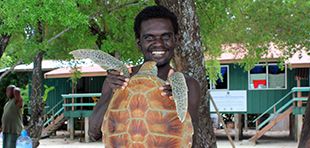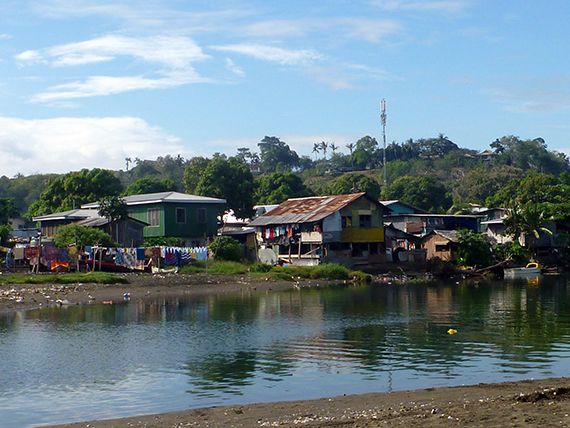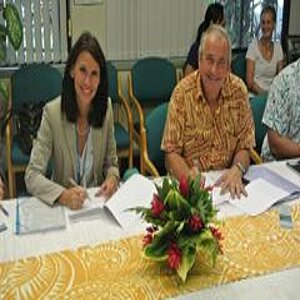Ecosystem-based adaptation in the Solomon Islands

The South Pacific island state inaugurated its first marine protected area in May 2017.
On 11 May 2017, the Government of the Solomon Islands announced the opening of the Arnavons Community Marine Park (ACMP). It is the first marine protected area in the island state, which is situated to the south-east of New Guinea. The ACMP encompasses the three uninhabited Arnavon Islands, which form part of the Solomon Islands group, and is home to the largest South Pacific colony of hawksbill sea turtles. This sea turtle is threatened with extinction as a result of overhunting for its meat, eggs and in particular its shell, but also because of the destruction of its breeding grounds and habitat on beaches and in the water. The turtle was included on the ‘red list’ of critically endangered species by the International Union for Conservation of Nature (IUCN) in 1996. With the help of The Nature Conservancy, relevant communities, provincial and national Government departments came together to protect the islands.
Henry Kaniki is manager of the marine protected area and promotes the protection and recovery of stocks. ‘My long-term objective for the ACMP is for it to become a conservation model not just for the Solomon Islands, but for the entire Pacific region,’ he says. Because the approach actively involves the islands’ inhabitants, Kaniki also sees the protected area as a form of living laboratory. Young people work as rangers, monitor nesting sea turtles, maintain the beaches and support research work. Students are able to experience nature conservation at first hand on field trips. Solomon Islanders also benefit individually from the new marine protected area. Water and food, living space and income – all are dependent to a large extent on the natural resources, which it is in their interest to protect.
The protected area is adjacent to Wagina island – a project site of the Pacific Ecosystem-based Adaptation to Climate Change Project (PEBACC). The project operates in the Solomon Islands, as well as in Fiji and Vanuatu; and promotes ecosystem-based adaptation (EbA) to climate change. Its activities are focused on strengthening and protecting the role of natural ecosystem services to enhance resilience to climate change.
The protected area means an important development for the communities of Wagina as the biodiversity benefits from it and therfore enhances the resilience of their natural resource based livelihoods. In this sense the initiative is complementary to the objectives of PEBACC which are to promote conservation, sustainable management and restoration of natural ecosystems. This to help people adapt to climate change and at the same time provide significant co-benefits for them and biodiversity.
PEBACC is supported as part of the International Climate Initiative (IKI) of the German Federal Ministry for the Environment, Nature Conservation, Building and Nuclear Safety (BMUB) and implemented by the Secretariat of the Pacific Regional Environment Programme (SPREP).
Marine resource exploitation is not the country’s only challenge. Unsustainable agriculture, deforestation, uncontrolled timber processing are other challenges that impact on key environmental resources such as water catchment areas. The number of people living in the capital Honiara increased by 35% to 87,000 between 2009 and 2015; by 2050 it will rise to around 180,000. This is equivalent to one third of the entire population. For this reason, the PEBACC project carried out a study entitled Ecosystem and Socio-economic Resilience Analysis and Mapping (ESRAM); based on the findings, it recommends the introduction of urban green spaces and measures to protect and restore river ecosystems and upper catchment areas.
Also imperative is intensified cooperation at all levels of government and the incorporation of climate change mitigation and adaptation into legislation. Both the botanic gardens in Honiara and the catchment area of the River Mataniko, on which the city lies, have already been declared areas requiring special attention from the Government and municipalities. An implementation plan detailing various options based on the findings of the ESRAM study is currently under development.
The link has been copied to the clipboard
Contact
IKI Office
Zukunft – Umwelt – Gesellschaft (ZUG) gGmbH
Stresemannstraße 69-71
10963 Berlin




